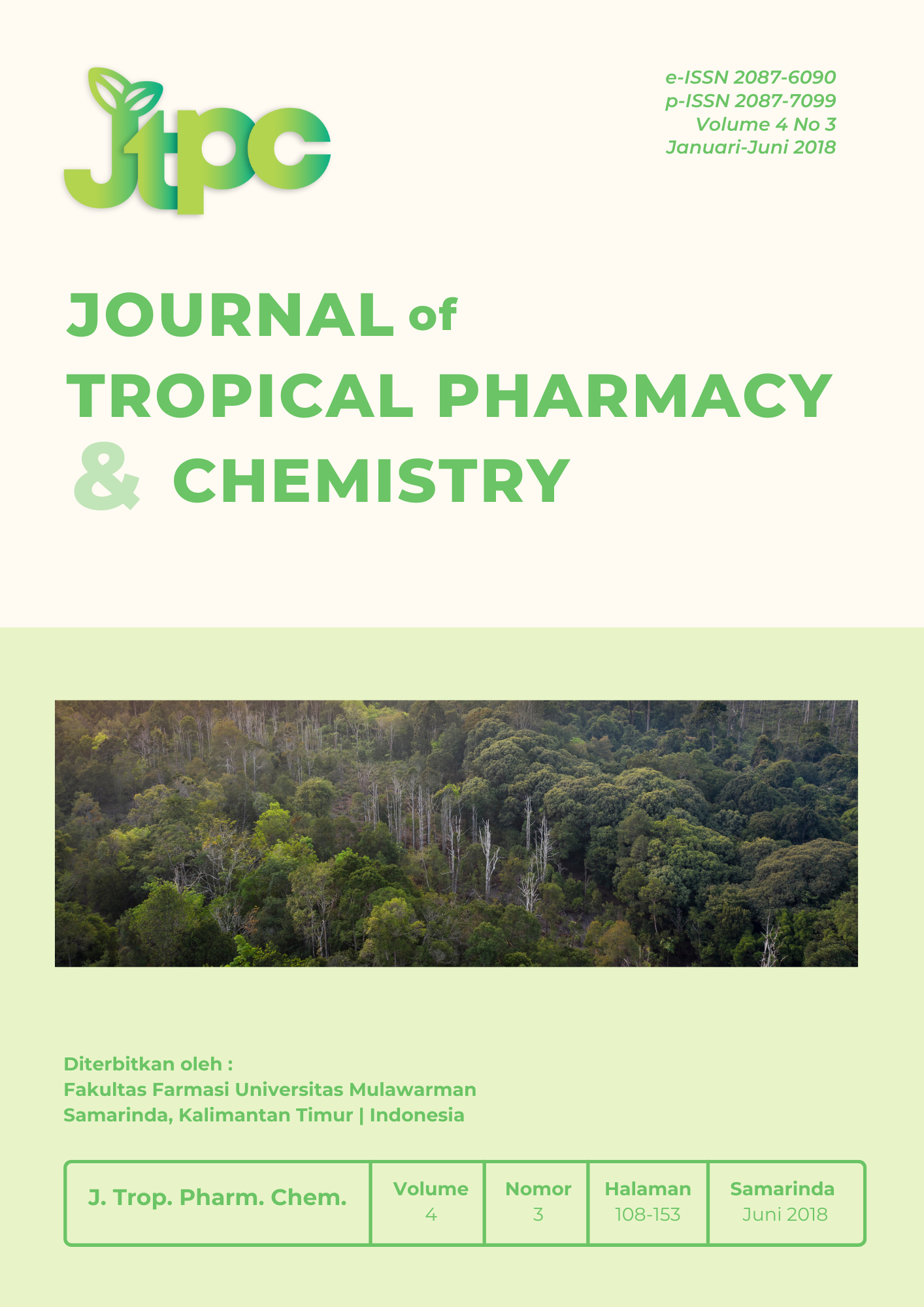Effect of Ethanol Extract of Eleutherine bulbosa (Mill.) URB on Anaerobic Bacterial Prophyromonas gingivalis In Vitro
DOI:
https://doi.org/10.30872/j.trop.pharm.chem.v4i3.178Keywords:
Eleutherine bulbosa, Prophyromonas gingivalis, Inhibition Zone, Antibacterial Agents, PeriodontitisAbstract
Periodontitis is an inflamation of supporting tissues on teeth that became the main cause of Prophyromonas gingivalis (P. gingivalis) bacteria. Treatment of periodontitis is by giving antibacterial agent therapy. Plants that have antibacterial effects one are Eleutherine bulbosa (UEB) bulbs from the Iridaceae family. This plant has been used for ethnobotany boils drugs and has been known to have antibacterial activity toward against intestinal pathogen bacteria that is anaerobic Gram Negative, but still unknown its activity against on oral pathogenic bacteria such as P. gingivalis. The purpose of this study was to know the effect of UEB extract on the growth of P. gingivalis bacteria as in vitro. UEB is taken from agriculture center in Samarinda city. UEB Simplisia was tested for antibacterial activity using Kirby-Bauer disc diffusion method on BHI-A media supplemented with vitamin K and hemin. The bacteria which used were P. gingivalis ATCC® 33277. Blank disc 6 mm with nine concentrations attached to BHI-A medium, incubated for 24 hours at 37 °C in an anaerobic atmosphere, then sprayed MTT (3-[4,5 Dimethylthiazole-2-yl]-2,5 diphenylttetrazoliumbromide) reagent and read a few moments later. For comparison, then used Chlorhexidine gluconate (CHX) 2 mg/ml. The statistical analysis with t-test and there was significant different if p<0.05. The result showed that the higher concentration of UEB ethanol extract will increase the growth inhibition zone of P. gingivalis bacteria and reach maximum at 10 mg/ml concentration. The result of t-test showed no difference significant of P. gingivalis bacterial inhibition zone in the treatment group of 7.5 mg/ml and 10 mg/ml concentration on CHX group. This study proves UEB ethanol extract can inhibit the growth of P. gingivalis bacteria.
Downloads
References
Nair, S., & Anoop, K. 2012. Intraperiodontal pocket: An ideal route for local antimicrobial drug delivery. Journal of Advanced Pharmaceutical Technology & Research, 3(1), 9-15. doi: 10.4103/2231-4040.93558.
Langlais, P. 2013. Atlas Berwarna Lesi Mulut yang Sering Ditemukan, 4th ed., Rasyad EM, editor, Jakarta: EGC.
Petersen, E., & Ogawa, H. 2012. The Global Burden of Periodontal Disease: Towards Integration With Chronic Disease Prevention and Control, Periodontology 2000, 60(1), 15-39. doi: 10.1111/j.1600-0757.2011.00425.x.
Eke, P., Dye, B., Wei, L., Slade, G., Thornton-Evans, G., Borgnakke, W,. Taylor, G., Page R., Beck, J., & Genco, R. 2015. Update on Prevelence of Periodontitis in Adults in the United State: NHANES 2009 to 2012. Journal of Periodontology, 86(5), 611-622. doi: 10.1902/jop.2015.140520.
Badan Pengembangan dan Pembangunan Kesehatan. 2013. Riset Kesehatan Dasar, RISKESDA 2013, Jakarta: Kementrian Kesehatan RI.
Mysak, J., Podzimek, C., & Sammerova, L. 2014. Review Articel Prophyromonas gingivalis: Major Periodontopathic Pathogen Overview, Journal of Immunology Reaserch, 55-62. doi: 10.1155/ 2014/476068.
Puspadewi, R., Adirestuti, P., & Menawati, R. 2013. Khasiat Umbi Bawang Dayak (Eluetherine palmifolia (L.) Merr) Sebagai Herbal Antimikroba Kulit, Kartika Jurnal ILmiah Farmasi, 31-37.
Padhi, L., & Panda, S. 2015. Antibacterial Activity of Eleutherine bulbosa Againts Multidrug Resistant Bacteria, Journal of Acute Medicine, 5(3), 53-61. doi: 10. 1016/j.jacme.2015.05.004.
Henry, L., Aruni, W., Senbreg, L., & Fletcher, H. 2013. Proctetive Role of the PG1036-PG1038 Operonin Oxidative Stress in Prophyromonas gingivalis W83, PLOS ONE, 8(8), e69645 1-14. doi: 10.1371/journal.pone.0069645.
Clinical and Laboratory Standards Institute. 2012. Performance Standards for Antimicrobial Disc Susceptibility Test; Approved Standard-Eleventh Edition, CLSI Document M02-A11, Wayne: Author. Available form https://clsi.org [Accesed 2017 July 23].
Davis, W., & Stout, T. 1971. Disc Plate Method of Microbiological Antibiotic Assay: Factor Influencing Variability and Error. Applied Microbiology, 22(4), 659-665. Available form https://www.ncbi.nlm.nih.gov/m/pumbed/5002143/ [Accesed 2017 July 23].
Ifesan, B., Jaycharat, N., & Voravuthikunchai, S. 2009. The Mode of Antistaphylococcal Action of Eleutherine americana, FEMS Immunol Med Microbial, 57, 193-201. doi: 10.1111/j. 1574-695X.2009.00599.x.
Kumar, S., & Pandey, A., K. 2013. Chemistry and Biological Activities of Flavonoids: An Overview. The Scientific World Journal, 2013, 1-16. doi: 10.1155/2013/162750.
Cushnie, T., & Lamb, A. 2005. Review Antimicrobial Activity of Flavonoids. International Journal of Antimicrobial Agents, 26, 343-356. doi: 10.1016/j. ijantimicag.2005.09.002.
Cushnie, T., Cushnie, B., & Lamb, A. 2014. Alkaloids: An Overview of their Antibacterial, Antibiotic-enchancing and Antivirulence Activity, International Journal of Antimicrobial Agents, 44(2014), 377-386. doi: 10.1016/j.ijantimicag.2014.06.001.
Ifesan, B., Ibrahim, D., & Voravuthikunchai, S. 2010. Antimicrobial activity of crude ethanolic extract from Eleutherine americana, Journal of Food, Agriculture & Environment, 8, (3&4), 1233-1236. Available form https://world-food.net [Accesed 2017 June 13].
Ferraz, C., Gomes, B., Alexander, Z., Teixeria, F., & Souza-Filho, F. 2007. Comparative Study of the Antimicrobial Efficacy of Clorhexidine Gel, Clorhexidine Solution and Sodium Hypochlorite as Endodontic Irrigants, Braz Dent J, 18(4), 294-298. Available form https://www.ncbi.nlm.nih.gov/m/pubmed/18278298/ [Accesed 2017 July 20].
Anggayanti, N., Adiatmika, I., & Adiputra, N. 2013. Berkumur dengan Teh Hitam Lebih Efektif dari pada Clorhexidine Gluconate 0,2% untuk Menurunkan Akumulasi Plak, Jurnal PDGI, 62, 35-34.




